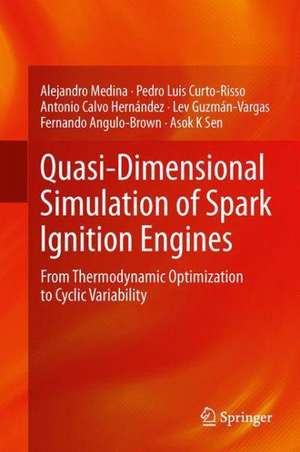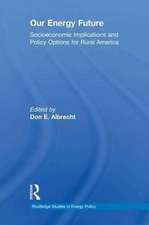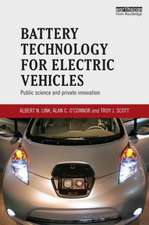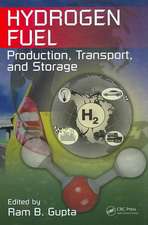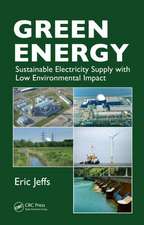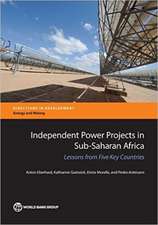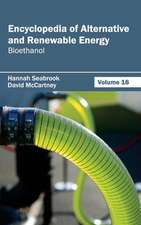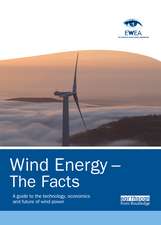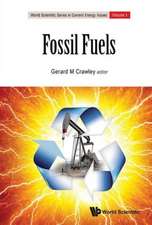Quasi-Dimensional Simulation of Spark Ignition Engines: From Thermodynamic Optimization to Cyclic Variability
Autor Alejandro Medina, Pedro Luis Curto-Risso, Antonio Calvo Hernández, Lev Guzmán-Vargas, Fernando Angulo-Brown, Asok K. Senen Limba Engleză Hardback – 3 sep 2013
Including details about the structure of a complete simulation scheme, information about what kind of information can be obtained, and comparisons of the simulation results with experiments, Introduction to Quasi-dimensional Simulation of Spark Ignition Engines offers a thorough guide of this technique. Advanced undergraduates and postgraduates as well as researchers in government and industry in all areas related to applied physics and mechanical and automotive engineering can apply these tools to simulate cyclic variability, potentially leading to new design and control alternatives for lowering emissions and expanding the actual operation limits of spark ignition engines
| Toate formatele și edițiile | Preț | Express |
|---|---|---|
| Paperback (1) | 636.30 lei 6-8 săpt. | |
| SPRINGER LONDON – 23 aug 2015 | 636.30 lei 6-8 săpt. | |
| Hardback (1) | 641.20 lei 6-8 săpt. | |
| SPRINGER LONDON – 3 sep 2013 | 641.20 lei 6-8 săpt. |
Preț: 641.20 lei
Preț vechi: 754.36 lei
-15% Nou
Puncte Express: 962
Preț estimativ în valută:
122.71€ • 127.64$ • 101.30£
122.71€ • 127.64$ • 101.30£
Carte tipărită la comandă
Livrare economică 12-26 aprilie
Preluare comenzi: 021 569.72.76
Specificații
ISBN-13: 9781447152880
ISBN-10: 1447152883
Pagini: 212
Ilustrații: XIII, 195 p.
Dimensiuni: 155 x 235 x 17 mm
Greutate: 0.44 kg
Ediția:2014
Editura: SPRINGER LONDON
Colecția Springer
Locul publicării:London, United Kingdom
ISBN-10: 1447152883
Pagini: 212
Ilustrații: XIII, 195 p.
Dimensiuni: 155 x 235 x 17 mm
Greutate: 0.44 kg
Ediția:2014
Editura: SPRINGER LONDON
Colecția Springer
Locul publicării:London, United Kingdom
Public țintă
ResearchCuprins
1.Introduction.- 2.Physical laws and model structure of simulations.- 3.Validating and comparing with experiments and other models.- 4.Thermodynamic engine optimization.- 5.Cycle-to-cycle variability.- App.A.Derivation of the basic differential thermodynamic equations.- App.B.Flow rates and valve geometry.- App.C.Flame front area calculations.- App.D. Heat transfer areas.- App.E.Combustion chemistry.- App.F.Alternative fuels.- App.G.Reference geometric and configuration parameters for numerical computations.
Notă biografică
Prof. A. Medina graduated in Physics in 1990 (Universidad de Salamanca, Spain) and obtained his PhD in 1993 working on the infrared spectroscopy of simple molecules in dense media. From then his research interests evolved towards the theoretical analysis of different thermal engines, specially the computer simulation of internal combustion engines and power plants. He spends his spare time practicing several outdoors sports as cycling and mountaineering. He is also a passionate traveller and reader.
Assistant Professor P.L. Curto-Risso obtained a degree in Mechanical Engineering in 2004 at Universidad de la República (Montevideo, Uruguay) and his PhD in 2009 at Universidad de Salamanca (Spain), working on the numerical simulation of internal combustion engines. His research interests involve computational analysis of different thermal engines and topics related with combustion phenomena and heat transfer.
Prof. A. Calvo Hernández obtained his PhD in Physics in 1985 (Universidad de Salamanca, Spain). His present research interests are focused on the analysis of unified thermodynamic aspects of diverse energy converters. His preferred spare time activities are walking and bird watching.
Lev Guzmán-Vargas is Associate Professor at National Polytechnic Institute, Mexico.
He did his doctoral work (Ph. D., 2002) in nonlinear analysis of time series. Lev
has worked in the areas of time series analysis, nonlinear dynamics and complex systems.
He is also interested in exploring the organizational properties of complex networks with applications to physical, biological and social systems. He lives in Mexico City.
Fernando Angulo-Brown is full Professor at Escuela Superior de Física y Matemáticas, Instituto Politécnico Nacional (MéxicoCity). His main fields of interest are non-equilibrium thermodynamics and seismology. He has been physics teacher during more than forty years and advised bachelor, master or doctorate thesis to more than fifty students.
Asok K. Sen received his bachelor’s degree in Mechanical Engineering from the Indian Institute of Technology, Kharagpur, India, and his master’s degree also in Mechanical Engineering from the University of Minnesota, USA. He received his Ph.D. in Theoretical and Applied Mechanics from Cornell University, USA. He has held visiting positions at the California Institute of Technology, Northwestern University, Cornell University, and the University of Toronto. Currently, he is a professor of Applied Mathematics at Indiana University. His research interests are in the application of various signal processing techniques to the analysis of nonstationary time series arising in the fields of energy and environment.
Assistant Professor P.L. Curto-Risso obtained a degree in Mechanical Engineering in 2004 at Universidad de la República (Montevideo, Uruguay) and his PhD in 2009 at Universidad de Salamanca (Spain), working on the numerical simulation of internal combustion engines. His research interests involve computational analysis of different thermal engines and topics related with combustion phenomena and heat transfer.
Prof. A. Calvo Hernández obtained his PhD in Physics in 1985 (Universidad de Salamanca, Spain). His present research interests are focused on the analysis of unified thermodynamic aspects of diverse energy converters. His preferred spare time activities are walking and bird watching.
Lev Guzmán-Vargas is Associate Professor at National Polytechnic Institute, Mexico.
He did his doctoral work (Ph. D., 2002) in nonlinear analysis of time series. Lev
has worked in the areas of time series analysis, nonlinear dynamics and complex systems.
He is also interested in exploring the organizational properties of complex networks with applications to physical, biological and social systems. He lives in Mexico City.
Fernando Angulo-Brown is full Professor at Escuela Superior de Física y Matemáticas, Instituto Politécnico Nacional (MéxicoCity). His main fields of interest are non-equilibrium thermodynamics and seismology. He has been physics teacher during more than forty years and advised bachelor, master or doctorate thesis to more than fifty students.
Asok K. Sen received his bachelor’s degree in Mechanical Engineering from the Indian Institute of Technology, Kharagpur, India, and his master’s degree also in Mechanical Engineering from the University of Minnesota, USA. He received his Ph.D. in Theoretical and Applied Mechanics from Cornell University, USA. He has held visiting positions at the California Institute of Technology, Northwestern University, Cornell University, and the University of Toronto. Currently, he is a professor of Applied Mathematics at Indiana University. His research interests are in the application of various signal processing techniques to the analysis of nonstationary time series arising in the fields of energy and environment.
Textul de pe ultima copertă
Based on the simulations developed in research groups over the past years, Introduction to Quasi-dimensional Simulation of Spark Ignition Engines provides a compilation of the main ingredients necessary to build up a quasi-dimensional computer simulation scheme. Quasi-dimensional computer simulation of spark ignition engines is a powerful but affordable tool which obtains realistic estimations of a wide variety of variables for a simulated engine keeping insight the basic physical and chemical processes involved in the real evolution of an automotive engine. With low computational costs, it can optimize the design and operation of spark ignition engines as well as it allows to analyze cycle-to-cycle fluctuations.
Including details about the structure of a complete simulation scheme, information about what kind of information can be obtained, and comparisons of the simulation results with experiments, Introduction to Quasi-dimensional Simulation of Spark Ignition Engines offers a thorough guide of this technique. Advanced undergraduates and postgraduates as well as researchers in government and industry in all areas related to applied physics and mechanical and automotive engineering can apply these tools to simulate cyclic variability, potentially leading to new design and control alternatives for lowering emissions and expanding the actual operation limits of spark ignition engines
Including details about the structure of a complete simulation scheme, information about what kind of information can be obtained, and comparisons of the simulation results with experiments, Introduction to Quasi-dimensional Simulation of Spark Ignition Engines offers a thorough guide of this technique. Advanced undergraduates and postgraduates as well as researchers in government and industry in all areas related to applied physics and mechanical and automotive engineering can apply these tools to simulate cyclic variability, potentially leading to new design and control alternatives for lowering emissions and expanding the actual operation limits of spark ignition engines
Caracteristici
Presents the main ingredients for a quasi-dimensional computer simulation scheme Compares simulation results with experiments and estimates from other models Aimed at the introductory student
